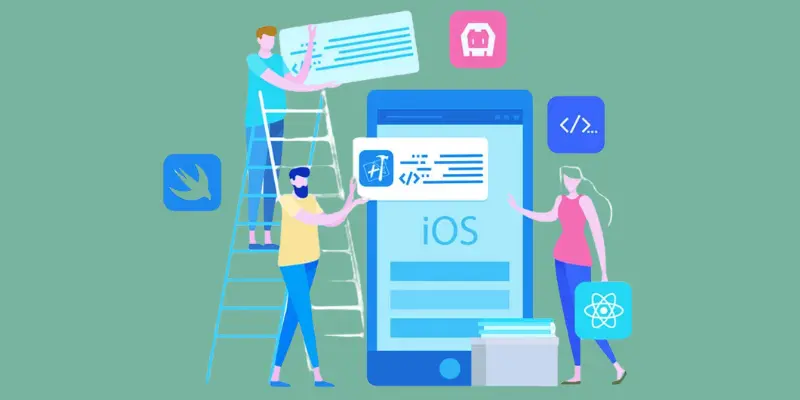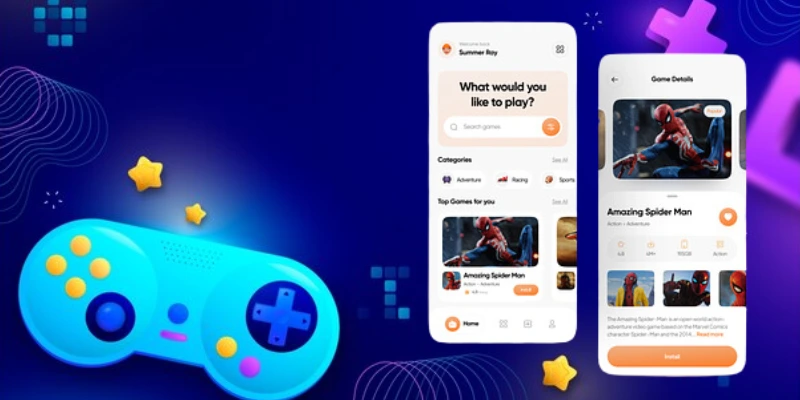Have you ever wondered what it will cost to develop an application for mobile games? Of course, you'll make a rough estimate in your mind, but will it be enough to get with the development process? No!
The developing cost of a gaming app can vary from zero to $174 million, the current record for the costliest game to develop.
Before you opt for Gaming App Development Solutions, it is essential to be aware of the costs involved in development. This will help you create a solid budget, ensure a wise allocation of resources, and reduce risk efficiently.
In this guide, we'll discuss the development of mobile game apps, cost, the most important considerations of mobile game development, cost-effective strategies, and more.
Overview of the Mobile Gaming Market Share and Statistics
The mobile gaming world isn't just vast; it is also constantly changing and influenced by user preferences, technological advances, and global developments. Let's look at the present market share and the statistics that define the mobile gaming industry, providing a complete overview of its scope and growth potential.
Current Market Size and Growth Trends:
The world's mobile gaming industry rose to unimaginable heights, boasting an estimated market value of $92.6 billion. This staggering figure shows the industry's booming growth and growing demand for mobile gaming.
For those looking at potential income, it's essential to remember that the development cost for games for mobile devices can vary from $10,000 to $250,000, based on the quality and features. Knowing these trends is essential for those looking to tap into the latest markets and benefit from the industry's rising trend.
User Demographics and Preferences:
Understanding the user's preferences and demographics is vital to creating games that resonate with the intended audience. Research shows that a majority of smartphone players are between 18 and 34 years old, and there is a near-the-same proportion of male and female gamers. Popular genres like action games, strategy, and game titles dominate, highlighting how important it is to align the development efforts with the needs of the players.
For example, hugely loved games like "Among Us" gained immense popularity because of their basic but engaging multiplayer game, which attracted players of all ages and became a phenomenon in the world of culture.
Emerging Markets and Opportunities:
While mature markets continue to significantly contribute to industry revenue, emerging markets offer potential that is not fully explored. In places such as Southeast Asia and Latin America, mobile gaming is undergoing rapid growth, driven by an increase in the number of smartphones and an expanding middle class.
Hire gaming app developers who want to achieve international success should monitor these markets and be aware of the specific issues and preferences unique to each region. Additionally, issues like the growth of 5G technology, the integration of AR (AR), and the creation of custom software applications are all contributing to the evolution of the industry, opening up new opportunities in immersive experiences for gamers.
Explore the data that shape the mobile gaming market, giving you insights that go beyond the raw figures. This knowledge provides the basis for strategic decision-making in the ever-changing and competitive mobile game application development market.
How Much Does It Cost to Develop a Mobile Game?
If someone comes up with a brilliant idea, the expense of implementing the concept comes first to mind. Mobile games are becoming significantly well-known. Additionally, they have become an extremely lucrative market and offer many money-making opportunities. Technology such as virtual reality and Augmented Reality have created mobile games that are more exciting and enjoyable. Notably, the development of the mobile gaming industry has not shown any signs of slowing. The number of gamers playing mobile games is rising, and mobile gaming apps are among the most downloaded games.
According to reports, the Global Online Games revenue is expected to increase to $17.8 billion by 2024.
According to the statistics, the market for serious games is projected to grow by 24 billion by 2024.
According to reports, the gaming market is predicted to reach USD $256.
The 2025 development of mobile game applications is a complex task because there are many factors to consider when making a great mobile game. Furthermore, competition for mobile games is extremely tough; therefore, it will not create a lasting impression when your game isn't visually or functionally appealing.
To determine the cost of developing a mobile gaming app, it is essential to comprehend the aspects that must be considered when designing a mobile game application.
Theme and Story:
The ability to attract players' attention is not easy because there are a lot of games to pick from. Each game is built around the basis of a story, which is why the plot is what makes it interesting. Be sure the storyline for your game is intriguing enough to keep participants interested. In addition, to create an appealing storyline, you must develop the characters and character traits. It is also essential to decide how characters will interact with each other and how they will keep them engaged.
To create a unique story and characters for your game, Effective communication between professional strategists and game designers is essential. Finding a skilled game designer is not expensive. It will cost you between $100 and $150 for an hour.
Design:
The design of a mobile game application is a complicated and multilayered process. When designing, the user targets, game environments, games, game levels, and gameplay are all planned. Additionally, if the game's plan is well-planned and executed with care, the game can be prone to many errors and bugs.
To finish the design of your game, you will require the assistance of expert game artists, game architects, and UI and UX designers. In addition, the expense of hiring competent and skilled experts can vary between $150 and $250 per hour.
Categories and Genres:
After you've completed the game's design, it's time to develop it. This is also an important and costly stage, as the price of the game application will depend greatly on the kind of game you're creating. A casual game app is different from a social or simulation gaming app.
Different kinds of games come with various levels of difficulty. Based on their level of complexity, games for mobile devices can be classified as:
-
-
Casual or mini mobile application games are basic and simple games that don't require any particular skill or knowledge. The cost of these games is approximately $10,000. Additionally, if you would like to improve the quality of the game by adding additional graphics, costs will rise.
-
Games played on social networks are enjoyed by various players on the most popular social websites. These games require limited data from players and are identical to games played on browsers. The price of games on social media, such as Farmville, could range between $50,000 and $100,000.
-
Casual 2D games are low-cost games with simple 2D graphics. Although they are simple in their graphics, they have great engagement rates and excellent scaling opportunities. 2D games such as Stack are in this category and priced between $ 25,000 and $50,000.
-
Mid-level games feature distinct levels of stories, characters, and top-quality graphics. The well-known video game Angry Birds is the best illustration of mid-level games. The content's depth increases the chance of keeping gamers engaged. A mid-level game could cost anywhere from $250,000 to $700,000.
-
Applications for business games are designed to engage groups of players. They are multilayered games that include thrilling graphics, storyline levels, soundtracks, and animation. Developing games like these requires skilled programmers for mobile apps and costs from $250,000 to $550,000.
-
The most expensive games are high-end. These games require careful strategies, a thorough understanding of the game, and an outstanding design. The development of a top-quality game may take longer than a year. The cost of developing these games ranges from $400,000 to $1,000,000.
-
Testing:
Testing an app for mobile gaming is as crucial as the development. The game should be smooth and efficient, so there shouldn't be any bugs. The general rule is that people don't enjoy games full of bugs. It is essential to have money for the testing process. Several game development companies provide testing services as part of the overall project.
Marketing:
Finding a fantastic mobile game concept and developing it into a reality is a huge accomplishment. However, no matter how amazing the game is, it will not launch without a marketing expert's help. Additionally, it is essential to implement a well-planned marketing plan to compete with competitors and reach the right players. Creating a budget for marketing your game's mobile app is vital as it can improve its exposure.
Factors Affecting The Mobile Game Development Cost
Here are the most essential elements that directly impact on the overall development cost of mobile apps:
Genre and Category of the Game
The genre and the category of a mobile game play an important role in determining the development costs.
Mobile game genres are classified based on various criteria, including the game's platform, game modes (single-player or multiplayer, PvP, etc. ), and narrative themes (horror or mystery, and much more).
The genre chosen directly impacts development costs. For instance, creating a multiplayer open-world game could be more difficult and expensive than creating a puzzle game for one player.
However, it's crucial to remember that a genre alone cannot provide a specific cost estimation.
This is because there is additional categorization of genres such as fight games, adventure games, RPGs, puzzles, sports games, simulations, strategy games, and so on.
Each subcategory requires unique gameplay mechanics.
For example, strategy games require the development of complex economic systems, whereas fighting games require a variety of combat styles for different characters.
This complexity significantly contributes to the overall development costs of mobile games.
Game Type and Complexity
The difficulty of a sport directly corresponds to its price. Every new feature and component increases the total cost.
In terms of their scope and complexity, mobile games are classified as medium, small, or huge. They may also be classified into various categories, such as casual games, business games, social games apps, or middle-level and high-level games.
Other factors that can significantly influence the development cost are the style of animation (2D as well as 3D) and 3D games that require higher budgets.
GDD (Game Design Document)
GDD (also known as Game Design Document) (GDD) is precisely what it is referred to as a complete written document that provides every essential aspect of your game.
A well-organized Game Design Document should be emphasized during the development of mobile games. It acts as a roadmap toward a successful final product
It is important to realize that constructing a top-quality GDD is not only a necessity but also a labor-intensive job that requires a substantial expenditure of time and funds.
An average Game Design Document (GDD) is divided into subsections and sections that provide the specifics of the most critical aspects of your mobile game.
The most important sections usually include:
-
-
General Game Descriptions: It gives an in-depth look at the game, which includes its narrative, setting, and overall idea that defines the game experience.
-
Design Basics: It helps dive into the game's fundamental mechanics, detailing the gameplay's objectives, features, and user interaction, which are crucial to players' experiences.
-
Data on Business and Technical Information: This section focuses on details about the requirements for technical development, platform aspects (such as iOS and Android compatibility), monetization strategies, and other business-related issues that affect development and costs.
-
Selecting a Mobile Platform
Unity and Unreal Engine, the most popular engines for games on mobile devices, don't impact the cost of developing games for mobile devices.
However, if the mobile game's requirements become too complicated and the mobile game engine needs to be changed during development, it can result in higher costs.
The most important thing to consider when choosing a mobile platform is to choose cross-platform game engines.
This allows for the simultaneous launch of the game for both iOS and Android, eliminating the requirement for different development resources for the two platforms.
Some of the top game engines optimized for a variety of platforms include:
-
-
Unity
-
Unreal Engine
-
Construct 3
-
Defold
-
Game Maker Studio 2
-
Godot
-
Game Development Time
The time needed to create a mobile game differs depending on its size and complexity.
Making a simple mobile game with a simple storyline usually takes 2 to 4 months.
As the game grows in complexity and size, the development time will also increase. The most complex games might require one or more years to complete.
Another crucial aspect that influences the cost of developing mobile games is the location of the development team.
For instance, Game app development services offered in the US will cost between $100 and $150 per hour, depending on the game's complexity and the skills required.
Furthermore, complex and grand games usually require the expertise of various professionals, such as game and narrative creators, artists, producers, writers, testers, and many more specialists.
Their contributions collectively affect the development timeframe and, in turn, the cost.
Mobile Game Testing
Testing for mobile game applications is not an optional process; it's equally important as the stage of development.
Today's players are getting increasingly annoyed by game-related bugs and issues.
The importance of having a seamless and error-free gaming experience can't be overemphasized. Gamers cannot stand games that are plagued by bugs or slow performance.
They want an experience in gaming that is not just free of issues but also gives a whole and astonishing user experience.
Game application development companies typically include testing services as a crucial component of the entire project development.
It's a vital step when creating a game, as no game can be released without thoroughly testing bugs.
Additionally, it is essential to remember that the game's complexity level correlates to the amount of testing needed. Mobile game testers typically offer hourly rates; the more complicated your game is, the more comprehensive testing is required.
Thus, the accuracy of your testing procedure is an essential element of development and a necessary factor in determining the total development cost for mobile games.
Mobile Game Development Cycle
It is important to account for every stage of the development process when calculating the costs of developing mobile games.
Pre-Production
In the stage before production, you transform your concept into a plausible, realistic Game Design Document (GDD). GDD includes vital areas such as the game's primary idea (the hero is able to save our world from the threat of a horrible cosmic monster) as well as the plot, the layout of characters, user interfaces, visuals, and the specific levels of the game. It also defines the game's goal audience and the mechanisms for monetization to be implemented after its release. Sometimes, at this point, the team also builds an early prototype.
Production
This is where you can design, code writing, test, and design. In addition, here, you collaborate with voice actors to determine the character's voice and work with marketing to create your community for shipping. (It's essential! We'll discuss it later.) When you're sure your game is ready to be evaluated by real-life players, you launch an initial launch to a smaller portion of the public to check the concept, mechanics, story, etc.
After collecting feedback, your team will polish the game. After addressing any issues, inconsistencies, mistakes, and other issues that the Soft launch has assisted in detecting, it's time to conduct an overall launch.
Post Production
After launching the game, the maintenance phase begins. During this phase, you introduce new features, levels, upgrades, etc., to keep gamers engaged and to continue developing your storyline. You also respond to their feedback and fix any bugs.
How to Monetize A Game App?
There are various ways to earn money from an app on mobile, such as in-game purchases, premium downloads, in-game ads, subscriptions for ongoing use, and sponsorships.
Incorporating the monetization method in your mobile application ensures that you will earn money every time a person installs the app.
In general, there are a variety of methods of app monetization that can make money through mobile gaming. Here are the specifics:
Ongoing Subscriptions
The ongoing subscription is a viable way to earn money, which mobile game designers often use.
Users must pay a monthly fee, usually monthly or annual, to enjoy the game's premium features, content, or other benefits.
The subscription model could provide steady income streams while ensuring users are engaged.
The pricing options vary, from budget-friendly monthly costs to premium subscriptions with extra perks catering to various segments of users.
Premium Paid Downloads
Paid premium downloads can be a simple way to make money where the user pays an upfront cost to download and use your game.
This strategy is most efficient when you have a game with quality, unique content that customers are willing to spend money on.
Although it is possible to earn income without using advertising or purchases in games, it's important to provide outstanding value to justify the initial investment to players.
Premium paid downloads can be an instant source of income and can be monetized using other strategies to boost the amount of money earned.
Sponsorships
Sponsorships can be a very lucrative way to earn money from mobile-based games.
This approach involves partnering with other brands or businesses to advertise their services and products within your game.
You could earn a steady income by displaying advertisements. This strategy is especially effective when your game has an active and loyal player base.
It's crucial to ensure that the content sponsored by sponsors is in line with the theme of the game and doesn't interfere with the experience of players
-
-
Purchases in-game
-
Another monetization method commonly employed by mobile app creators is incorporating mobile features that require users to purchase authentically.
The best part about these applications is that they're open to all users without fees, but the developers have a few features locked and require users to purchase real cash.
-
-
Freemium
-
The premium apps are initially available to users as a free version without any additional cost.
However, when the players become comfortable with the game and begin to recognize the features and effort put into it, they will ask you to purchase the paid version.
We favor this monetization strategy over others because it helps users understand and evaluate the importance of your game and keeps them interested in it.
-
-
Advertising
-
If you're an avid player of mobile games, you'll agree that this is not the most popular. Nobody wants to be interrupted by ads while playing.
However, This is one of the methods developers use to earn profits from their gaming apps.
Cost-Effective Tips for Mobile Game App Development
Gaming Software Development Services require substantial investment. If you're looking for cost-effective methods without sacrificing quality, you should consider the following suggestions:
Clearly Define Project Requirements
Define the mobile app's specifications, including scope, goals, and requirements. Create a complete Proposal Requirement Document or PRD to reduce the development process's complexity. It should contain:
-
-
Making a comprehensive feature list
-
Establishing UI/UX guidelines
-
Setting deadlines
-
Developing budget estimates
-
The framework you want to create
-
A well-defined PRD will provide the development of a clear plan and can help avoid costly adjustments later.
Develop in Phases
The market is always changing, So what's effective today may not work tomorrow. It is important to break down the development process into phases. Start with the basics, then move on to more sophisticated features.
Prioritize the essential features that enhance your game's competitive advantage to speed up time to market and gather early feedback. This method allows for cost-effective modifications and adjustments.
Make your Budget Plan in Advance
Begin your project with a budget that clearly will cover the entire development cost. A comprehensive budget upfront will allow for efficient budgeting and tracking of expenditures throughout the development process.
Focus on Minimum Viable Products
Create a Minimum Viable Product that includes essential features that will fulfill the requirements of your intended market. Concentrating on key features lets you test the app on the market before moving on to full-scale development. Furthermore, it is the MVP method. It is cost-effective and allows for feedback from users collection and the ability to make app changes in response to the collected data.
Select an Experienced Development Team
Invest in hiring a reputable and skilled Mobile Game App Development Company. Working with design, development, and testing experts will ensure top-quality results and the project's success.
Opt for Cross-Platform Development
Use Cross-Platform Game Development tools like Unity and Unreal Engine Game Development to develop your game app on several platforms simultaneously. This will reduce the development time and costs associated with customizing your game for each platform, helping you reach a larger audience across different operating systems and platforms.
Utilize Automated Deployment Tools
Automating the deployment process simplifies updating and releases while minimizing the chance of human error and labor. It requires creating continuous integration to ensure effective development tests, security testing, and application configuration. This helps speed up software releases, increases reliability, and ensures that the software remains modern and competitive in the marketplace.
Test and Improve
Testing and iteration are essential to ensure cost-effectiveness. Constant testing and improvement during the entire development process can identify problems earlier, reduce delays, and ensure high quality. This method of improvement results in a more efficient and economically sound product.
Conclusion
While mobile games continue to increase in popularity and revenue, understanding the complexity associated with development expenses is essential.
This comprehensive guide gives essential information on the typical expenses of developing games, the various stages involved, and the numerous elements that affect these costs.
When you consider factors such as game genre and complexity, a team of developers, and monetization strategies, you can determine the amount of money required to fund the development of your mobile game.
Planning your spending budget, prioritizing your features, and evaluating cost-saving strategies are essential to managing development costs efficiently.
As the mobile gaming market continuously grows, it's the perfect time to begin your development adventure and capitalize on its huge potential.












Share this blog